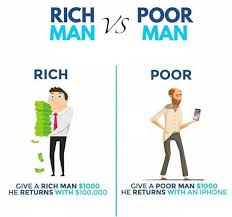Top 10 Difference Between Habit Of Rich And Poor People.

Who are rich people?
We should firstly discuss who rich people look like.
Rich people are those that have financial security, what I mean by financial security, is ability to afford expenses either those that are planned or not planned. You may have money but not able to secure expenses of unforeseen circumstances, you are still poor, but mid-poor person.
Rich people are the like of Dangote, Tinubu, Otedola and so on.
Who are poor people?
Poor people are those that don’t have any financial security at the lowest minimal, they can’t afford most of their planned expenses talk less of unforeseen one.
Poor People find it’ difficult to afford their 3 square meal, and such things that you think can afford. Being poor sometimes has to do with individual mindsets. There are certain trait that poor people have like, low energy, low IQ and poor mindset.
Comparison between poor people and rich people habits
READ ALSO » Top 10 Secrets Of The World Most Richest People You Should Learn
As much as we all strive for financial stability and success, the difference between rich and poor people is not just about how much money they make. Several significant disparities separate the two, from how they dress to how they invest. This article will explore the eleven most essential differences between rich and poor people.
- Clothing
- Spending Habits
- Positive Vs. Negative
- Risk-Taking Habits
- Investing Habits
- Health Habits
- Buying Habits
- Personal Finance Habits
- Income
- Commitment
1. Clothing

Designer labels and high-end fashion are frequently associated with wealth and success, and wearing them is seen as a sign of one's social status. This isn't always the case, though. Rather than wearing expensive designer brands, many wealthy individuals prefer quality, affordable clothing. They are able to value money over the superficial appearance of wealth thanks to this approach to clothing. Conversely, poor individuals frequently overspend on clothing in an effort to project wealth while actually wasting their hard-earned money. It is essential to keep in mind that quality should always come first and that spending money on clothes that last longer and are of higher quality can help you save money in the long run. By avoiding excessive spending and prioritizing quality over quantity, you can construct a wardrobe that serves you well. The majority of self-made millionaires place a high value on investing their money and avoiding extravagant clothing purchases. Because they don't have a boss, the rich don't dress for work. The majority of the best-dressed individuals are employed at high salaries and are not wealthy. Take, for instance, Mark Zuckerberg's hoodie and CZ's blue jeans, New Balance shoes, and black turtleneck as billionaire CEOs of Facebook and Binance. These are two excellent examples of wealthy attire worn for comfort rather than to impress others.
2. Spending Habits
The way wealthy people and poor people spend their money is one of the main differences, and this has a lot to do with how they think. Regardless of their high net worth, wealthy individuals tend to be more disciplined and spend less than they earn. Because it enables you to save money and invest in opportunities to generate additional income, this is an important habit to cultivate in order to build wealth. However, poor people frequently begin their financial struggles with a low income and then add to their problems by spending too much, purchasing unnecessary items, and living beyond their means. It can be difficult to achieve long-term financial objectives because this kind of spending can quickly result in debt and financial instability. Some of the most expensive habits include drinking, smoking, drinking beer, going to bars, being addicted, and getting tattoos. These bad habits can make you poor or keep you poor. By converting their earned income into assets through smart investments, the self-made rich become wealthy. You can build a solid financial foundation and work toward a brighter financial future by prioritizing spending and avoiding unnecessary expenses.
3. Optimistic Vs. Pessimistic
The power of positive thinking has long been touted as a critical factor in achieving success and happiness in life, this also has to with mindset. This principle is especially evident in the contrasting outlooks of the rich and the poor. Rich people view obstacles as opportunities for growth, development, and a chance to prove themselves. They approach challenges with a positive mindset, believing that they can overcome any hurdle that comes their way. In contrast, poor people often view obstacles as insurmountable barriers to success. They tend to focus on the negative aspects of a situation and become overwhelmed by the challenges they face. This negative mindset can lead to hopelessness and discourage them from achieving their goals. While a positive mindset doesn’t guarantee wealth, a negative mindset can keep you broke.
4. Risk-Taking Habits
Rich people are unafraid to take risks and pursue new opportunities that can lead to tremendous success. They understand that taking calculated risks is necessary for growth and are willing to step outside their comfort zones to achieve their financial goals. On the other hand, poor people often shy away from risk-taking and choose to stay in their current low-paying job or bad relationship situations out of fear of failure or the unknown. However, by avoiding risks, they may miss out on potential opportunities that can lead to a better life. Taking calculated risks can lead to new experiences, personal growth, and financial success. The rich tend to take smart, calculated risks in investments and businesses where they have an edge. The poor tend to avoid risk altogether or take bad risks like gambling on sports, going to a casino, or playing the lottery where the odds are against them.
5. Investing Habits

The wealthy and the poor differ significantly in their investment strategies. Wealthy individuals are aware of the significance of investing in assets that have the potential to grow their wealth and generate long-term income. They research investment opportunities carefully and base their decisions on their objectives and risk tolerance. But poor people frequently spend their money on things that won't help them in the long run, like buying consumer goods on impulse. They miss out on potential opportunities to increase their wealth and ensure their financial future by not investing their money wisely. It is essential to place a high priority on investing in assets that contribute to long-term financial stability and passive income. The stock market is used by the wealthy to invest in businesses, while the poor only use the products and services of those businesses.
6. Health Habits
One significant difference between rich and poor people is how they prioritize their health. Most wealthy individuals understand that caring for their physical and mental well-being is essential to success. They prioritize regular exercise, eating nutritious foods, and getting enough sleep to maintain optimal health. In contrast, poor people often neglect their health due to a lack of resources, time, or knowledge. They may rely on fast food or processed snacks as a quick and cheap option, leading to health problems and decreased productivity. Neglecting their health can also impact their ability to work and earn a living. Therefore, it’s essential to prioritize maintaining good health habits, even with limited resources, to improve overall well-being and success. Drinking, smoking, and addictions can also destroy the health and finances of the less fortunate that get involved in them.
7. Buying Habits
READ ALSO » Top 10 Inspirational Stories Of People Who Overcome Their Disabilities
Rich people prioritize long-term savings over short-term indulgences when it comes to money. They understand that by investing in high-quality items, they can save money in the long run. For example, purchasing a good quality coffee machine for your home may seem expensive upfront. Still, it will save you significant money in the long term compared to buying a daily coffee from Starbucks. By investing in these types of items, they can save money over time and limit ongoing expenses. In contrast, poor people often opt for cheaper, lower-quality things like clothes from the dollar store, thinking they will save money quickly. However, this usually costs them more in the long run, as these more affordable items need to be replaced more frequently. Overall, investing in high-quality items that last or replace the need to buy things daily, like coffee on the go, can save you money in the long run and is a common trait among the wealthy. The rich look at the total cost of what they buy and whether it is worth it.
8. Personal Finance Habits
Managing money is a crucial skill that distinguishes rich people from poor people. Rich people are often diligent about avoiding unnecessary debt and creating a monthly budget to help them stay on track with their finances. They understand that taking on debt can lead to financial hardships and limit their ability to save money. In contrast, poor people often rely on credit to compensate for their lack of cash and do not create monthly budgets. This approach can result in a cycle of debt that becomes increasingly difficult to break. Managing money effectively means being mindful of spending, creating a plan to pay off debt, and saving money for future goals. The rich spend all their money on paper before the month begins.
9. Income
Having only one source of income can be risky, especially during tough economic times. Wealthy people understand the importance of diversifying their income streams and often invest in assets such as stocks, real estate, and businesses. This enables them to have multiple sources of income, which can provide stability and security in the long run. Many rich people also earn passive income through royalties, rental properties, or other investments that generate cash flow without requiring active participation. By having multiple income streams, rich people can increase their wealth and reduce their financial risks.
The poor are typically trapped with one source of income from a low-paying job; some even have a second job to pay their living expenses. To break the cycle of being poor, they must get on track in a career that will reward skills, experience, or education with higher pay. You can also like to read about top 10 successful forex strategy to increase your income.
10. Commitment
A strong commitment to achieving financial success is frequently the driving force behind rich people. They are aware that hard work, perseverance, and dedication are necessary to achieve wealth. To help them achieve their objectives, they are willing to invest in themselves through networking opportunities, education, or training. They are also willing to put in more time and effort to achieve their goals of becoming educated, starting a business, or moving up to a position with a higher salary in their professional field. They were eager to make the necessary sacrifices because they were aware that self-made people cannot take shortcuts to financial success. They are distinguished from those who are less focused on achieving financial success by their dedication and commitment.
Conclusion
Rich and poor individuals differ in more ways than just their income levels. Wealthy people frequently put what is most important to their financial success first, invest their money wisely, and have multiple income streams. Additionally, they have a upbeat outlook and are willing to take risks in order to achieve their financial objectives. On the other hand, poor people frequently spend too much on things that aren't necessary, fail to build a rewarding career, and have a negative outlook on life. Anyone can work toward improving their overall quality of life and achieving financial success by adopting the lifestyle and practices of successful people. It is essential to keep in mind that building wealth is a long-term process that necessitates dedication, discipline, and the willingness to make short-term sacrifices in order to achieve long-term objectives.
